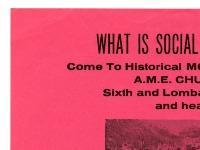As a major American city, Philadelphia was the site of important conferences and a destination for key figures in the civil rights and Black Power movements. The Thelma McDaniel Collection includes flyers announcing two very different meetings that took place at Philadelphia churches in the 1960s. In this lesson, students are given the opportunity to research the Black Power movements in Philadelphia to give context to their analysis of these meeting flyers.
Civil Rights Meeting Flyers
Civil Rights Meeting Flyers
Essential Questions
Objectives
Students will be able to:
- Identify and evaluate conflict and cooperation among social groups and organizations in United States history from 1890 to the present.
- Evaluate how continuity and change have influenced United States history from 1890 to the present.
- Cite specific textual evidence to support analysis of primary and secondary sources, connecting insights gained from specific details to an understanding of the text as a whole.
Primary Sources
Other Materials
Suggested Instructional Procedures
1. Familiarize yourself with Black Power using the Meeting Flyers Background Information sheet. Give students a short lecture.
2. Present the two meeting flyers to the students. Have students research the names of key players and institutions on the flyers such as Church of the Advocate, Stokely Carmichael, SNCC, CORE, Father Paul Washington, Mother Bethel A.M.E. Church, Andrew Young, and SCLC. Students will share their findings with the class.
3. Compare the two meetings using the provided worksheet. Discuss what the differences and similarities were in terms of what type of people were in the audience, the content of the speeches, the size of the event, etc.
4. Have students write for assessment on the prompt: If you had a time machine, which meeting would you want to attend and why?
Vocabulary
United Negro College Fund: “UNCF (United Negro College Fund) is the nation's largest and most effective minority education organization. UNCF provides operating funds for 38 member historically black colleges and universities (HBCUs), scholarships and internships for students at about 900 institutions and faculty and administrative professional training.” From the UNFC website
Homogeneous: being the same or similar

Plans in this Unit
Grade Level
Duration
Standards/Eligible Content
This publication has been financed in part with Federal funds from the National Park Service, U.S. Department of the Interior. However, the contents and opinions do not necessarily reflect the views or policies of the Department of the Interior. This program receives Federal financial assistance for identification and protection of historic properties. Under Title VI of the Civil Rights Act of 1964, Section 504 of the Rehabilitation Act of 1973, and the Age Discrimination Act of 1975, as amended, the U.S. Department of the Interior prohibits discrimination on the basis of race, color, national origin, disability or age in its federally assisted programs. If you believe you have been discriminated against in any program, activity, or facility as described above, or if you desire further information, please write to: Office of Equal Opportunity, National Park Service, 1849 C Street, N.W., Washington, DC 20240.
About the Author
This lesson was created by Amy Jane Cohen. Updated for SAS by Casey Wernick and Amy Seeberger, Education Interns, of the Historical Society of Pennsylvania.
Attention Teachers!
Let us know how you used this plan and be featured on our site! Submit your story here.

